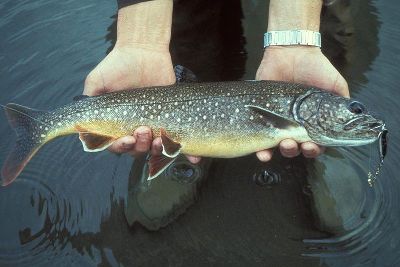
The lake trout or mackinaw is a top-level predator and the largest of the freshwater trout and char family. Native to the Great Lakes, lake trout were extirpated from Lake Erie and Lake Superior due to sea lamprey predation and other factors. Re-stocking efforts have resulted in a rebound of lake trout in the Great Lakes region.
Lake trout have been introduced into impoundments in the Mid Atlantic region with varying success. Lake trout prefer large cool lakes that contain abundant prey. When present, they feed heavily on emerald shiners, alewives, and other forage species.
Lake trout are commonly caught by trolling spoons or other brightly colored lures in deep areas. Anglers sometimes experience good catches of lake trout by locating suspended schools of fish and then adjusting their equipment until lures reach the proper depth.
They are also caught by vertical jigging or presenting live baits at various depths. In some areas, lake trout are caught along the shoreline by anglers casting lures or flies.
In New York, lake trout are common in many of the larger impoundments, including Finger Lakes; Skaneateles, Owasco, Cayuga, Seneca, Keuka, Canandaigua, Canadice, Hemlock, Great Lakes; Erie, Ontario, Lake Champlain, Lake George, and Kensico Reservoir. They are also stocked into smaller impoundments throughout the state.
In New Jersey, Merrill Creek Reservoir and Round Valley Reservoir are known for their lake trout fisheries.
In Pennsylvania, Raystown Lake is known for its lake trout fishing. Lake Erie has produced multiple state record lakers.
Related Information